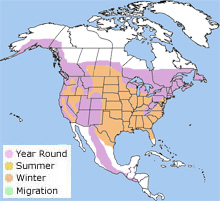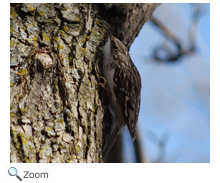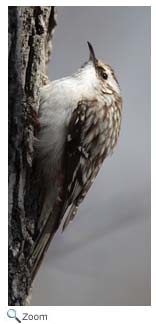Description
 The brown creeper is also known as the American tree creeper. It is the only native species of treecreeper in North America. It is around 4.75 inches in length. It has a long, thin, curved bill and a long, stiff tail that it uses to help keep itself steady as it moves around in trees. It is brown with white spots and streaks on its upperside and white on its underside. Its uppersides look a lot like tree bark. Males and females look the alike, but the male has a slightly longer bill. The brown creeper is also known as the American tree creeper. It is the only native species of treecreeper in North America. It is around 4.75 inches in length. It has a long, thin, curved bill and a long, stiff tail that it uses to help keep itself steady as it moves around in trees. It is brown with white spots and streaks on its upperside and white on its underside. Its uppersides look a lot like tree bark. Males and females look the alike, but the male has a slightly longer bill.
Range  The brown creeper is found throughout much of North America from Alaska and Canada south to Central America.
It is a year-round resident in many parts of its range, but some northern populations may migrate south in the winter. The brown creeper is found throughout much of North America from Alaska and Canada south to Central America.
It is a year-round resident in many parts of its range, but some northern populations may migrate south in the winter.
Habitat
The brown creeper is found in coniferous and mixed coniferous-deciduous forests. It needs habitats with tall old or dead trees. |
|
Diet
 The brown creeper gets its name from the way it creeps along tree trunks and branches
in search of insects, spiders, and other invertebrates, which make up almost all of its diet. It occasionally eats seeds in the winter.
It starts at the bottom of the tree trunk and creeps up the tree in a spiral and probes for insects with its long, pointed bill.
Its coloring makes it hard to spot as it creeps along the tree trunks! The brown creeper gets its name from the way it creeps along tree trunks and branches
in search of insects, spiders, and other invertebrates, which make up almost all of its diet. It occasionally eats seeds in the winter.
It starts at the bottom of the tree trunk and creeps up the tree in a spiral and probes for insects with its long, pointed bill.
Its coloring makes it hard to spot as it creeps along the tree trunks!
Life Cycle
 The male brown creeper sings to attract a mate. Once he has attracted a female, they both fly around, flutter their wings, and chase each other. The male also feeds the female during courtship and while she is nesting. The male and the female select a nesting site, but the female builds the nest. The brown creeper's nest is almost always built under a loose flap of bark on a dead or dying tree. Cocoons and spider egg cases are used to make a base for a cup-shaped nest made of bark, leaves, plant fibers, and feathers. The female lays between four to eight white eggs with pink to brown spots. The female incubates the eggs, and the male brings her food. The eggs hatch in 14-17 days and the chicks fledge in 13-16 days.
Both the male and the female feed the chicks. The male brown creeper sings to attract a mate. Once he has attracted a female, they both fly around, flutter their wings, and chase each other. The male also feeds the female during courtship and while she is nesting. The male and the female select a nesting site, but the female builds the nest. The brown creeper's nest is almost always built under a loose flap of bark on a dead or dying tree. Cocoons and spider egg cases are used to make a base for a cup-shaped nest made of bark, leaves, plant fibers, and feathers. The female lays between four to eight white eggs with pink to brown spots. The female incubates the eggs, and the male brings her food. The eggs hatch in 14-17 days and the chicks fledge in 13-16 days.
Both the male and the female feed the chicks.
Behavior
After a brown creeper has finished climbing up one tree probing for insects, it will fly down to the base of another tree and start a new spiral climb to the top.
|


 The brown creeper is found throughout much of North America from Alaska and Canada south to Central America.
It is a year-round resident in many parts of its range, but some northern populations may migrate south in the winter.
The brown creeper is found throughout much of North America from Alaska and Canada south to Central America.
It is a year-round resident in many parts of its range, but some northern populations may migrate south in the winter.

